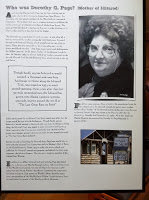One of the local spots that we visited was the Dorothy Page Museum. The focus is on the history of Wasilla. There is so much history here. Wasilla was a supply base for gold miners during WWII as well as serving fur trappers. It was the starting point for the Iditarod Trail Sled Dog Race from 1973-2002 until the weather got too warm. It out-populated Palmer, the previous leading city in the Matanuska-Susitna Valley, once the George Parks Hwy was constructed around 1970. The hwy became the major thoroughfare and railroad transportation corridor linking southcentral Alaska to interior Alaska. It was at this juncture that community development began to soar in Wasilla. Wasilla is now the 6th largest city in Alaska.
 |
| One of many tiny coffee drive thrus around town. |
 |
| Had to show you the size of the mosquitoes here…OMG! |
 |
| An antique piano…still works |
 |
There were several original
‘Wasilla’ buildings on the museum
property. Only the schoolhouse was
available to walk though…waiting on
budget for security cameras for the others |
 |
| Notice the tiny individual chalkboards |
 |
| Check out the message on the board…LOL |
 |
A young woman at the museum makes
each one of these scarves by hand…no 2
are alike. They are worn around the necks
of the stuffed animals for sale. |
 |
| Replica of the tents used during the Gold Rush |
 |
| Sample of vintage wares |
 |
| Cut away of the mining tunnels |
 |
| One of the mines |
 |
| Mine info |
 |
| Mural at the museum |
 |
This was soooo awesome!
I am standing at the base of the
stairs. The appearance of a
continuation into the tunnel is
a “3-D” painting on the wall.
It was such a weird sensation when standing at the top of the steps! |
Back to Dorothy Page. She is considered the “Mother of the Iditarod.” In 1966 she held an office that afforded her the task of planning an event to commemorate the 100th anniversary of Alaska being purchased from Russia. She decided to organize a “spectacular dog race to wake Alaskans up to what mushers and their dogs had done for Alaska.” With the support of Joe Redington, Sr., in February 1967, an all-star field of 58 mushers competed in the 50 mile Iditarod Trail Seppala Memorial Race which was run in two 25 mile heats. Afterwards, the public lost interest for awhile. Redington; however, was not deterred in attempting to keep the dream of a 1,000 mile race from Anchorage to Nome along the Iditarod Trail alive. So, in 1973, after much second guessing, the race took place. Now, 43 years after that initial 50 mile centennial race, the Iditarod has become Alaska’s greatest sporting event known around the world as “The Last Great Race on Earth.”
In addition to her role in founding the Iditarod Race, Page helped form the Iditarod Trail Committee and the Musher’s Hall of Fame and was very active in several other areas.
I don’t often do much history telling here, but I am quite taken by the history of Alaska and the sheer pride, loyalty and respect that I’ve seen in her residents. This story is but the tip of the iceberg of reasons to be in awe of those folks who risked life and limb to build this land into the thriving place that it is.
 |
Now look at the improved time as the years
went by. |
 |
Check out the number of days and hours
the race took at the beginning. |

















